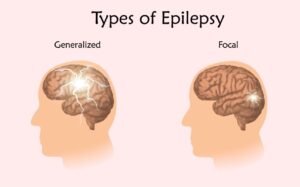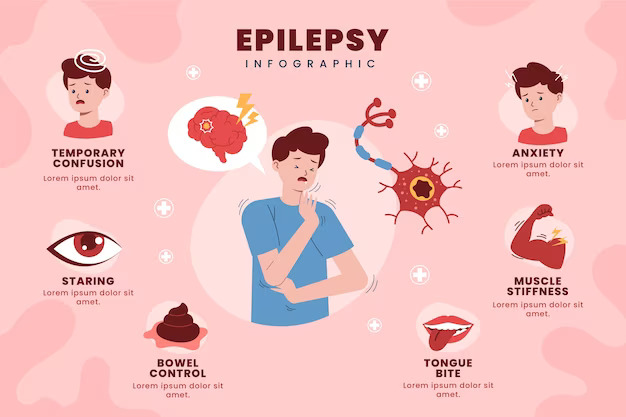Epilepsy is a neurological condition that affects millions of individuals worldwide.
In this blog article, we will look at epilepsy’s causes, symptoms, and the necessity of effective medical therapy.
What is epilepsy?
Epilepsy is a chronic condition marked by recurring seizures, which are transient disruptions in the electrical activity of the brain.Types of seizures: Highlight the many forms of seizures, such as generalized and focal seizures.

Causes of Epilepsy:
- Genetic factors.
- Brain injuries:
- Developmental disorders
Signs & Symptoms of epilepsy:
- Seizures are the defining characteristic of epilepsy. These can manifest in different ways:
- Generalized seizures: These seizures affect the entire brain and can cause loss of consciousness, convulsions, and muscle stiffness.
- Focal seizures: Seizures that originate in a specific area of the brain can cause altered consciousness, unusual movements, or sensations that are limited to one body part.
- Auras are symptoms or warning signals that some people with epilepsy experience before having a seizure. Auras can manifest in a variety of ways, including odd tastes, scents, or visual distortions like déjà vu.
- Brief Bewilderment: People may go through a phase of confusion or disorientation following a seizure. The duration of this postictal state varies from a few minutes to multiple hours.
- A transient loss of consciousness may result from some seizures, especially absence seizures. People may appear “absent” or gaze blankly into space during these instances.
- Unplanned Motions: Extremity jerking or shaking are common uncontrollable motions associated with generalized tonic-clonic seizures. It’s crucial to remember that convulsions are not always the result of seizures.
- People who are having focal seizures may go into staring spells where they are unresponsive and may move repetitively.
- Automata:
- Automatisms are automatic, repetitive behaviors brought on by seizures. Lip-smacking, chewing, and other meaningless motions are examples of these.
- Symptoms in the body:
- Many physical symptoms, including tingling in the extremities, numbness, and muscle weakness, can be present during a seizure.
- A shift in emotions:
- The presentation of epilepsy can be complicated by mood swings or emotional shifts that might happen before, during, or following a seizure.
Diagnosis :
- It’s really important to visit a doctor if you think you have epilepsy. They can figure out what’s going on and how to help you.
- Doctors might do tests like an EEG (brain wave test) or an MRI (a type of body scan) to understand more about what’s happening in your brain.
Treatment :
- Doctors might give you special drugs called antiepileptic drugs (AEDs) to help control your seizures.
- Healthy choices: Making good choices like getting enough sleep, managing stress, and staying away from things that trigger your seizures can also make a big difference.
Conclusion:
Epilepsy, while a complex condition, is manageable with the right medical care and support. By fostering awareness and dispelling myths, we can contribute to creating a more understanding and inclusive society for individuals living with epilepsy. If you or someone you know is affected by epilepsy, seek professional medical advice to ensure accurate diagnosis and optimal management.








0 comments on “Understanding Epilepsy: Intracris of the Seizure Disorders”